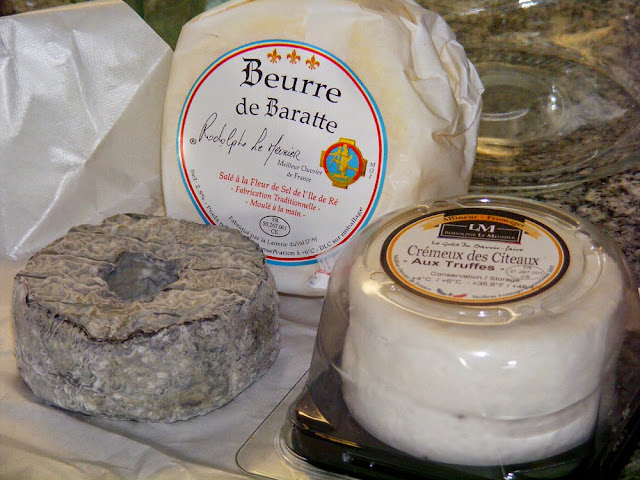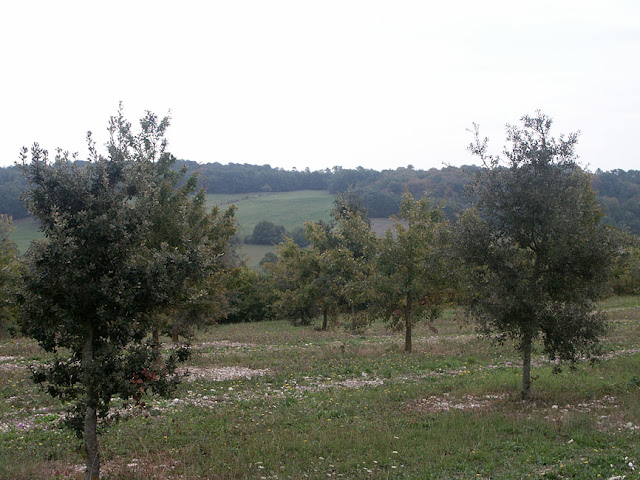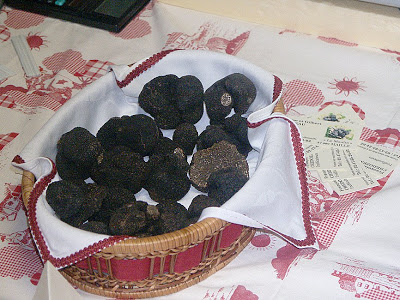Black Truffle Tuber melanosporum (Fr. Truffe noire) is native to the Loire Valley, but has long since disappeared from the wild. According to my expert botanist friend François the best place to find truffles was under isolated oak trees in the middle of wheat fields, but fifty years of modern farming practices and fungicides sprayed on wheat crops have destroyed the habitat for truffles. Nowadays they are cultivated, in orchards planted with inoculated oak trees. Black Truffles fruit in the winter, and over winter there is a series of specialist markets in the otherwise undistinguished village of Marigny-Marmande.
The first thing that strikes you about the truffle market is the pungent savoury smell. The dealers and big name chefs all get to the market at some ungodly hour and snap up the best quality tubers, classed as Category 2, for anything between one thousand and two thousand euros a kilogram. The market opens to the public at 9am and you need to get there between nine and ten if you want to get a top quality truffle. I’m a bit more relaxed about it though and am happy to get ‘unclassified’ truffles, for about 600 to 850 euros a kilo. These are truffles that have a defect, often just visual and not affecting their flavour, so they are downgraded and sold cheaper. Usually it will be something like a slug has munched on the tuber a bit, or it got slightly damaged when dug up, or even that it is just an irregular shape naturally. Nothing that taking a knife to it won’t solve. A walnut sized unclassified truffle (enough for two people) will cost about €20 and an egg sized one about €30.
 |
| A truffle orchard (beyond the buildings on the right) on the slopes of the spur which the Chateau de la Tour de Marmande sits. This is a typical truffle orchard location. |
Local growers tell me that alternating wet and warm weather from May to July is crucial to ensuring a good truffle harvest over the winter, from November to February. The markets before Christmas double as general seasonal gourmet markets, with other producers there to sell their venison, snails, nuts and dried fruits, preserves, winter pork and poultry products and cheeses, speciality breads, honey and wines. The markets after Christmas are all about the truffles, with far fewer stalls, and tree whips inoculated with truffle spores available for those who want to try a few in their garden for fun. Serious truffle buyers come in January, when the quality of the truffles is at its best. About 20 – 35 tonnes of truffles are harvested these days in the Loire Valley. Back in 1900 the harvest of wild truffles here was a thousand tonnes.
 |
The cheese on the right is a Crémeux des Citeaux, that has been split and given a layer of truffles. A gift to me from the cheese refiner Rodolphe le Meunier (very well known and respected in France, his products are available in New York I believe). For those of you who need to know, the cheese on the left at the front is a Couronne Lochoise, a goats milk cheese virtually unknown outside my local area. The package at the back is hand churned butter seasoned with traditionally produced salt from the Ile de Ré, off the Atlantic coast of France
Anyone with a truffle orchard is playing a long game. The trees will take at least ten years to produce a truffle, and some may never do so. Others will go on to produce truffles for thirty years or more. My friendly local truffle guru tells me that a good truffle orchard has a mixture of the local species of oak, and the evergreen species that is native to the south of France. The local oak is small, deciduous and adapted to the local poor dry chalky soils and will produce truffles earlier than the evergreen species, but is weakened by the truffles and has a shorter lifespan than the evergreens. He owns two lively truffle hounds, a Jack Russell called Pierre, and a wire haired dachshund called Odile. Truffle hounds can be any breed of dog, and are trained by getting them to play fetch with a truffle oil impregnated sparkling wine cork.
My favourite way of consuming truffles, by far, is to have them as a thin layer in a creamy cheese. Truffles need fat to bind to and release their flavour. They also need time and a little warmth, or at least room temperature. They are not easy to use to their best advantage. They frequently smell amazing but taste of nothing, and the fact that texturally they are a bit like sprinkling sawdust on your scrambled eggs, they can be a major disappointment if you are not careful.
 |
| Truffles for sale at the specialist market in Marigny-Marmande. |
 |
| Truffle trading at the specialist market in Marigny-Marmande. Buyers on the left, producers on the right. |
 |
| Brie that has been split and spread with truffle. |
 | ||||
 |
Unclassified truffles for sale at the specialist market in Marigny-Marmande. Note how the truffles are bobbly, and one has been cut in half so you can see that the interior is in good condition.
************************************************
For details of our private guided tours of chateaux, gardens, wineries, markets and more please visit the Loire Valley Time Travel website. We would be delighted to design a tour for you.
We are also on Instagram, so check us out to see a regularly updated selection of our very best photos.
We are also on Instagram, so check us out to see a regularly updated selection of our very best photos.



1 comment:
And all the ceremony that goes with them... https://inandaroundbraye.blogspot.com/2012/02/marches-aux-truffes-de-marigny-marmande.html
Brought back a few memories...
Post a Comment